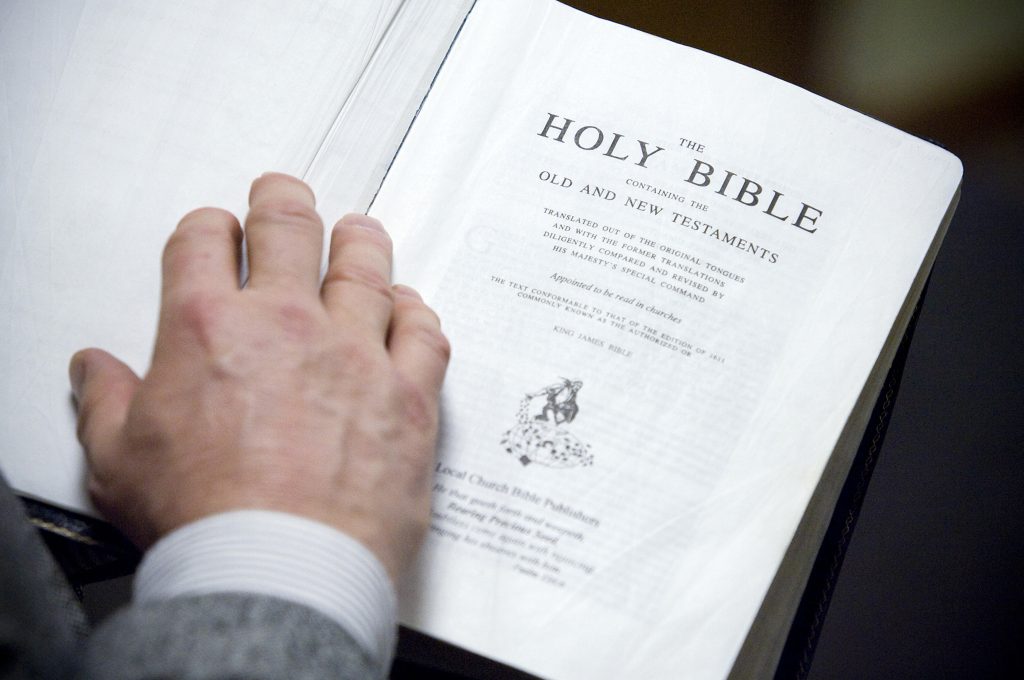Opinion | The case for Christianity
While many statistics may indicate a Christian decline in the U.S, there are various factors that show otherwise. Faith may look different, but it is still there.
Pastor Chris Huff, of Bible Baptist Church, in Mount Prospect, Illinois, holds his copy of the King James translation of the Bible, March 2, 2011. (Darrell Goemaat/Chicago Tribune/TNS)
April 20, 2023
Columns reflect the opinions of the authors and are not necessarily those of the Editorial Board, The Daily Iowan, or other organizations in which the author may be involved.
Fifty years ago, 90 percent of Americans were Christian.
Today, around 64 percent are Christians. The Pew Research Center predicts that less than half of Americans will be Christians, if the trend continues.
Some outlets report this as a decline in Christianity for the U.S., citing that church attendance decreased 15 percent post COVID-19.
Stephen Bullivant, author of “Nonverts: The Making of Ex-Christian America” and professor of theology and the sociology of religion at St. Mary’s University, elaborated on inter-generational differences in faith that also lower attendance.
“While grandparents might have been regular churchgoers,” Bullivant said in a Guardian article. “Their children would say they believe in God, but not go to church regularly. By the time millennials came [a]round, they had little experience or relationship with churchgoing or religion.”
For most of my life, I have been a non-denominational Christian, with a time during my high school years where I fell out of my faith because I didn’t feel like a “proper Christian.” The people around me who actively identified themselves as Christians conducted themselves differently than I did. Their families had nicer homes, and it felt like I couldn’t relate to them.
This lack of belonging is a reason many people fall out of faith too. But for me, it wasn’t too late.
I was introduced to a student ministry known as The Navigators by one of their staff members. I began to read the Bible to understand the faith more. The many stories and lessons in it brought me to a peace and knowledge no other book can come close to.
I participate in the ministry, and I share my belief with those around me, but unlike many, I don’t attend Church often because of timing and admittedly, sleeping in.
Church attendance is regularly used as a statistic for a population’s faith.
However, if there is one thing I learned in my readings, it isn’t in performance that shows one’s faith. It is in living and speaking as scripture being truth that outlines faith, which looks different for everyone.
“For it is by Grace you have been saved,” Ephesians 2:8-9 reads. “Through faith — and this is not from yourselves, it is the gift of God–not by works, so that no one can boast.”
For many people, a religious belief makes a big difference.
Statistically, those who have a religious faith see better health outcomes, according to the Mayo Clinic. In the study, prayer came second to pain-medication for handling the pain of an illness, and most studies saw a causal relationship between religious involvement and improved mental and physical health.
According to Gordon-Conwell theological seminary, there has been an annual 1.18 percent increase in Christianity worldwide, many of this seen in the global south. Africa has experienced the most growth out of every other continent. It’s important to keep in mind despite national trends, the Christian population is growing globally.
It is best that we keep our reactions in check when there is an “alarming” report of the downward trend in faith. Faith itself can’t be counted or measured in specificities. There will be people that will fall out, and there will also be those who are born again.



